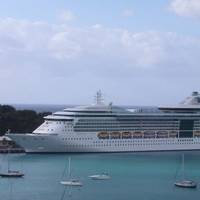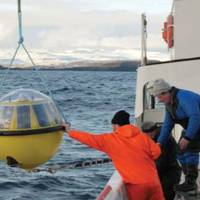Navigational Errors Caused Cruise Ship to Strike Pier in Alaska

Overreliance on an electronic chart, miscommunication and an outdated navigational chart were among factors that led to a cruise ship striking a pier last year near Sitka, Alaska, the National Transportation Safety Board (NTSB) said Tuesday.The Royal Caribbean cruise ship Radiance of the Seas was docking at the Sitka Sound Cruise Terminal on May 9, 2022, when it struck and damaged a mooring dolphin. The cruise ship sustained a minor hull indentation. The mooring dolphin sustained damage to three of the four pilings supporting it.
Great Lakes Ice Cover Among Worst in 40 Years
The Great Lakes saw some of their worst ice cover in nearly four decades because of a frigid winter with months of below-freezing temperatures in large sections of the northern United States, the National Ocean and Atmospheric Administration said. As of Thursday, 92.2 percent of the five lakes were under ice, breaking a record set in 1973 but still short of the 94.7 percent set in 1979, the federal agency said. The area under ice this winter covered about 86,000 square miles, which is a little bit larger than the state of Minnesota. With a spring thaw approaching and temperatures warming, the 1979 record appears poised to stand for at least another year.
Navy's Global Ocean Forecast System Goes Public

The U.S. Naval Research Laboratory (NRL) & the National Center for Environmental Prediction (NCEP) within the National Ocean and Atmospheric Administration (NOAA) have entered into a formal agreement that results in NCEP using Navy developed global ocean forecast model technology to make environmental ocean forecasts for public use. “Development of an advanced global ocean prediction system has been a long-term Navy interest,” said Dr. Gregg Jacobs, head, NRL Ocean Dynamics and Prediction Branch.
Industry, Government Collaborate on Long Island Sound Casualty Simulation
On September 17, McAllister Towing and Reinauer Transportation will be partnering with the U.S. Coast Guard Sector Long Island Sound and Sector New York in a major simulated marine accident and pollution incident on the waters of Long Island Sound. Responders will be faced with a simulated grounding and subsequent oil spill impacting the waters and shoreline of Connecticut and New York. The exercise is part of the National Preparedness for Response Exercise Program (PREP), a voluntary program bringing together industry and government to meet the exercise and preparedness requirements of the Oil Pollution Act of 1990, legislation enacted following the Exxon Valdez.
"The Future of Our Oceans"

On April 23, 2012, Dr. Stephen M. Coan delivered remarks entitled “The Future of Our Ocean”, part of the Open VISIONS Forum Lecture Series and presented at the Regina A. Quick Center for the Arts, Fairfield University, Fairfield, Conn. Following is the text of his speech. Water sustains life on Earth, and the health of our oceans, lakes, rivers, streams and marshlands, which cover 70% of the planet’s surface, is critically important to global economic and human health. Imagine this vast environment and what it could mean for us if we were able to better harvest food…
Delaware River Protection Act of 2005 Passes House
The U.S. House of Representatives has passed the Delaware River Protection Act of 2005, which was introduced earlier this year by Congressman Lobiondo (New Jersey) as a result of the Athos I oil spill in the Delaware River in November 2004. 1. Anyone who knows about the release from a vessel or facility into the navigable waters of the U.S. of any object that creates an obstruction to navigation shall notify the federal authorities. - USD 1700 in 2007 and after. Additionally, within 3 years after enactment of this law and every three years thereafter, the federal government shall adjust these limits to reflect the consumer price index (CPI). 3. The U.S.







